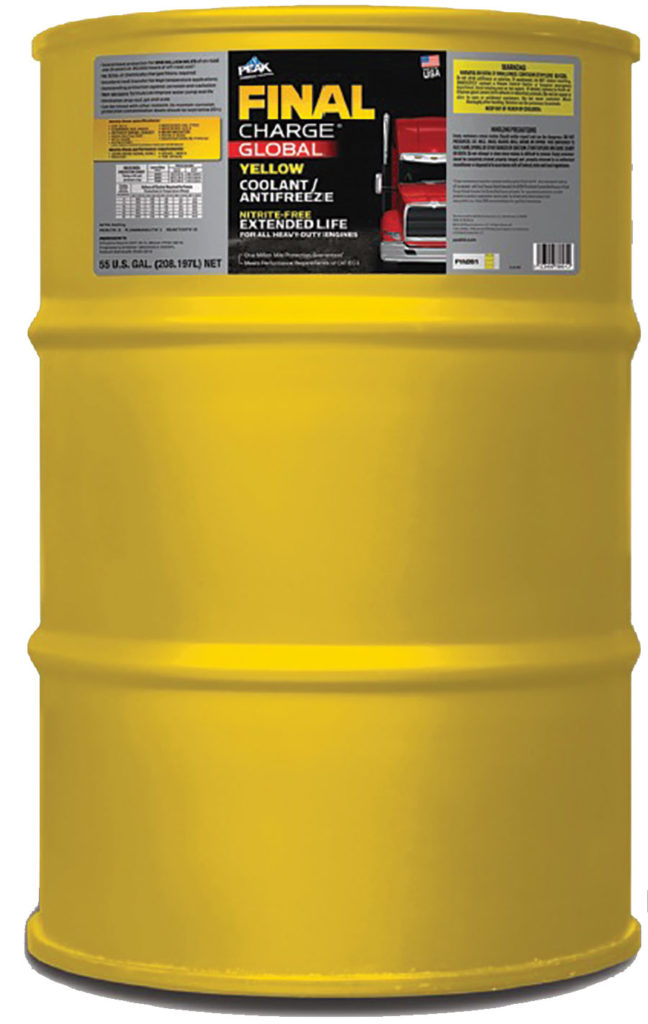Extended Life Coolants Increase Uptime, Cut Costs
October 17, 2016
Written By Adam Buckallew

Only a third of the energy created in the internal combustion engine of motor vehicles and equipment is used to move the vehicle. The rest is transferred as waste heat in equal amounts to the exhaust gas and engine coolant.
While water is an excellent heat transfer fluid, it’s relatively low boiling point, high freezing point and corrosive nature require the addition of ethylene glycol and corrosion inhibitors for it to be an effective engine coolant/antifreeze. The inhibitor system must be designed to protect the different types of metals that can be found in a typical cooling system, and, in heavy duty diesel engines, it must contain additives to prevent damage caused by cavitation (pitting) of the wet sleeve cylinder liners.
For many years, conventional engine coolants were dyed green and contained what is referred to as inorganic additive technology corrosion inhibitors. For light duty engines, the additives might include combinations of borate/silicate/nitrate or borate/phosphate/silicate/nitrate. Coolant additive packages for heavy duty engines also contain nitrite or nitrite/molybdate chemistry to address liner cavitation. When a heavy duty coolant comes pre-charged with the additive package, also called a Supplemental Coolant Additive or SCA, it is referred to as fully-formulated. This type of coolant has historically been dyed pink.
Because the heavy duty coolant additive package becomes depleted over time, it must be periodically tested using commonly available color test strips. A hand held refractometer is used to check the relative concentration of the coolant and water, and determine the effectiveness of the freeze protection. Typically, after 25,000 miles of use, SCAs must be added to restore the correct chemistry.
The potential for over or under addition of SCAs, or simply neglecting cooling system maintenance, means problems can and do occur. The additives can drop out of solution, causing deteriorating cooling system performance and wear in the coolant pump. This situation is greatly aggravated by poor coolant maintenance. In fact, more than 40% of diesel engine downtime is caused by cooling system failure. Even with good maintenance, conventional automotive or heavy duty coolant should be replaced very 2 or 3 years.
Use a 50/50 pre-mix over tap water. Tap water and even filtered water are full of minerals such as calcium and magnesium which leave deposits inside the entire cooling system – particularly around parts of the engine that reach high temperatures. With a pre-mix extended life coolant (ELC), you will have proper freeze point protection corrosion inhibitors and extended drain levels.
A major change has been the widespread adoption of organic acid technology extended life coolants (OAT ELC) such as FINAL CHARGE® Global Extended Life Coolant/Antifreeze. These feature organic carboxylate chemistry to address corrosion, lubrication and cavitation issues. The carboxylates act more locally to prevent corrosion as it begins, and form a protective film only where needed. This means they are depleted at a much slower rate than conventional coolant additives, and the coolant doesn’t need to be frequently checked to ensure it is providing adequate corrosion protection. Another benefit is that heat transfer at the metal surface is improved, especially important in today’s hotter-running heavy duty diesel engines.
Instead of the relatively short life of a conventional or fully-formulated coolant, which must be tested every 25,000 miles and drained and replaced typically at about 300,000 miles, FINAL CHARGE® Global Extended Life Coolant/Antifreeze can last 1,000,000 miles in on-road use, or 8 years/20,000 hours of off-road use.
With the advances that have been made with OAT ELC coolants, it should be an easy decision to move from conventional green and SCA pre-charged coolants to FINAL CHARGE® Global Extended Life Coolant/Antifreeze. Users will find a significant reduction in cooling system issues, resulting in fewer vehicle breakdowns and service visits. Extended life coolants provide the lowest total cost for owners in both product and labor savings because they eliminate the need for purchasing SCAs and chemically charged filters and the costs associated with coolant sampling and testing.

